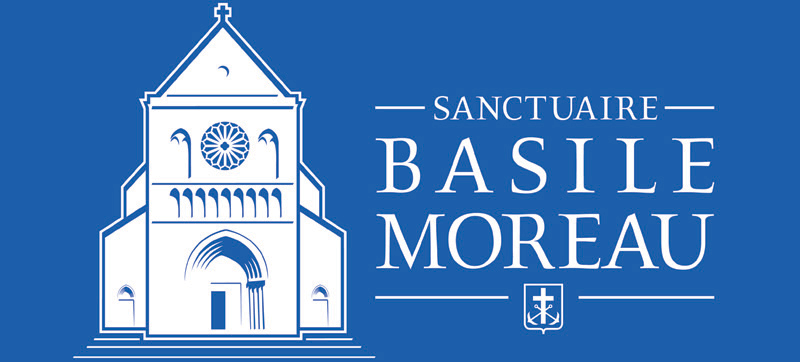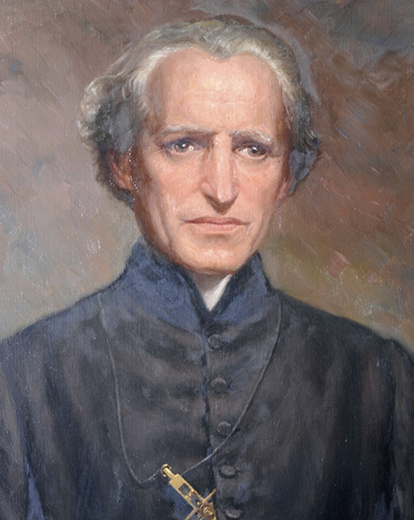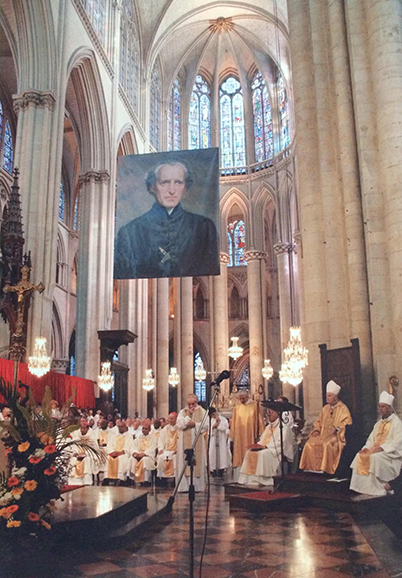Basil Moreau – Biography
Origins
Blessed Basil Anthony Moreau, the founder of the Congregation of Holy Cross, was born in Laigné-en-Belin, in the Diocese of Le Mans, France, on February 11, 1799. In 1821, he was ordained a priest for the Diocese of Le Mans. He later became a seminary professor, teaching philosophy and theology, while enthusiastically continuing to engage in pastoral work. He quickly gained a reputation as an inspiring professor and as a man of God who faithfully sought to grow in the image of Christ through prayer, personal asceticism, and service.
Basil Moreau grew up amidst the turmoil of post-Revolution France, and as a young priest felt compelled to revitalize a Church devastated by years of civil upheaval. With nearly two-thirds of France’s clergy and religious exiled or killed, Father Moreau organized a group of Auxiliary Priests to preach, teach, and bring the message of Christ to those in neglected towns and villages.
A new association
In 1835, Father Moreau assumed leadership over the Brothers of Saint Joseph, a community of laymen founded by Rev. Jacques Dujarié to work as educators in rural parishes. Father Moreau merged the priests and the brothers in 1837. This new association took its name from the town where it was based – Sainte-Croix (Holy Cross).
Basil Moreau’s vision was to maximize the spiritual vigor of this association by modeling it after the Holy Family. He completed the Holy Cross family by founding a group of sisters, known as the Marianites, who collaborated with the priests and brothers in the mission of evangelization.
Father Moreau gave to each of the three societies a patron. He consecrated the priests to the Sacred Heart of Jesus, the brothers to the pure heart of St. Joseph, and the sisters to the Immaculate Heart of Mary. He placed the entire family of Holy Cross under the patronage of Our Lady of Sorrows.
Growth and missions
Soon the Church outside of France began seeking the assistance of Moreau’s fledgling congregation. He sent priests, brothers, and sisters to other countries, including Italy, Algeria, Poland, the United States, Canada, and Bangladesh.
The Holy See officially declared Moreau’s institute to be a religious congregation – the Congregation of Holy Cross – in 1857 by approving the association’s Constitutions. The Holy See required that the sisters be recognized separately from the congregation of priests and brothers. The sisters later were approved as three separate congregations.
Moreau authored the Constitutions that were approved by the Holy See, as well as the set of Rules that accompanied them. He also composed Meditations, Spiritual Exercises, and a treatise on pedagogy entitled Christian Education. These were intended to aid in the spiritual and ministerial formation of his religious. In this way, Father Moreau, the founder, remained also the educator and teacher. He sought to bequeath to his Congregation a particular spirituality and charism to serve the Church and the world.
Challenges
While the Congregation of Holy Cross certainly enjoyed much growth and success, it also confronted severe challenges in the period shortly after its foundation. Father Moreau, who worked tirelessly for his Congregation of Holy Cross, himself suffered trials of various sorts, including abandonment by his own community. Nevertheless, placing his hope in the Cross of Christ and abandoning himself to Divine Providence, he continued to do the work of God, preaching missions until his health failed. The Marianites of Holy Cross cared for him to the end. He died in Le Mans on January 20, 1873.
Beatification
Basil Moreau was declared “venerable” by Pope John Paul II on April 12, 2003, and beatified by order of Pope Benedict XVI, on September 15, 2007, the Feast of Our Lady of Sorrows. He remains an inspiration to the consecrated men and women who make up the family of Holy Cross today, as well as to the faithful who have come to know him through the witness and ministries of Holy Cross religious throughout the world. We continue to pray for the canonization of this holy man of God, whose zeal for souls knew no bounds and who still works for our salvation from heaven.
“At first [Father Moreau] seems like one of those country priests from whom you do not expect very much, and whose appearance is in no way belied by his Le Mans accent, which pares down even further his great simplicity of speech… After speaking with him for a while, you notice that he has discerning eyes, that his mind is direct, firm and fertile, and that his heart is consumed with love. He is a great man and a saint.”
-Louis Veuillot, May 1846
Timeline
- February 11, 1799 – Born in Laigné-en-Belin, the ninth of Louis and Louise Moreau’s 14 children
- October, 1814 – Begins studies at the College of Château-Gontier
- September 18, 1816 – Receives tonsure at the hands of Bishop de Pidoll in the chapel of the bishop’s house at Le Mans
- Autumn of 1816 – Begins studies at St. Vincent’s Seminary in Le Mans
- April 7, 1821 – Ordained a deacon by Bishop de la Myre
- August 12, 1821 – Ordained a priest by Bishop de la Myre
- October 11, 1821 – Begins further studies at St. Sulpice in Paris
- July 21, 1822 – Arrives for a year of spiritual formation, similar to a Novitiate, at the Solitude in Issy
- 1823 – Appointed Professor of Philosophy at the Seminary in Tessé
- 1823 – Gives retreat to the Brothers of St. Joseph
- May 26, 1825 – Appointed Professor of Dogma at St. Vincent’s Seminary, Le Mans
- March 1830 – Transferred from teaching Dogma to teaching Scripture at St. Vincent’s Seminary
- 1835 – Appointed Assistant Superior at St. Vincent’s Seminary
- August 1835 – Founds the Auxiliary Priests in the Diocese of Le Mans
- August 31, 1835 – Becomes Superior of the Brothers of St. Joseph, assuming leadership from Rev. Jacques Dujarié
- November 1836 – Establishes the boarding school of Notre-Dame de Sainte-Croix in Le Mans
- March 1, 1837 – United the Brothers of St. Joseph and the Auxiliary Priests in the Fundamental Act of Union, thus forming the Association of Holy Cross
- April 28, 1840 – Inaugurates the first foreign mission of Holy Cross, sending religious from Sainte-Croix to Algeria
- May 1840 – Breaks ground on the Congregation’s Conventual Church at Sainte-Croix
- August 15, 1840 – Makes his Profession of Final Vows to Bishop Bouvier
- 1841 – Establishes the Marianites (sisters) of Holy Cross
- September 1, 1841 – Writes Circular Letter #14 laying out his vision for Holy Cross in imitation of the Holy Family
- 1848 – Publishes the first edition of the Meditations
- 1849 – Elected Superior General of Holy Cross for life
- October 1855 – Goes through a personal “Dark Night of the Soul”
- 1855 – Publishes his versions of the Spiritual Exercises of St. Ignatius
- 1856 – Publishes Christian Education
- May 13, 1857 – Receives from Pope Pius IX the approval of the Constitutions of Holy Cross, thereby making Holy Cross a Congregation
- June 17, 1857 – Participates in the consecration of the Conventual Church in Sainte-Croix
- June 14, 1866 – Receives acceptance from the Vatican of his resignation as Superior General
- April 28, 1869 – Moves into a house owned by his sister while continuing to preach parish missions and providing other parochial assistance in the surrounding area
- January 20, 1873 – Dies at the age of 73
- 1955 – Cause for sainthood introduced in Rome
- April 12, 2003 – Declared Venerable by Saint John Paul II
- April 28, 2006 – Approved for Beatification by Pope Benedict XVI
- September 15, 2007 – Beatified in Le Mans, France







